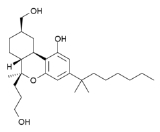
AM-919
Encyclopedia
AM-919 is an analgesic
drug which is a cannabinoid receptor agonist. It is a derivative of HU-210
which has been substituted with a 6β-(3-hydroxypropyl) group. This adds a "southern" aliphatic hydroxyl
group to the molecule as seen in the CP- series of nonclassical cannabinoid drugs, and so AM-919 represents a hybrid structure between the classical and nonclassical cannabinoid families.
AM-919 is somewhat less potent than HU-210 itself, but is still a potent agonist at both CB1 and CB2 with moderate selectivity for CB1, with a Ki
of 2.2nM at CB1 and 3.4nM at CB2.
Analgesic
An analgesic is any member of the group of drugs used to relieve pain . The word analgesic derives from Greek an- and algos ....
drug which is a cannabinoid receptor agonist. It is a derivative of HU-210
HU-210
HU-210 is a synthetic cannabinoid that was first synthesized in 1988 from -Myrtenol by the group led by Professor Raphael Mechoulam at the Hebrew University. HU-210 is 100 to 800 times more potent than natural THC from cannabis and has an extended duration of action...
which has been substituted with a 6β-(3-hydroxypropyl) group. This adds a "southern" aliphatic hydroxyl
Hydroxyl
A hydroxyl is a chemical group containing an oxygen atom covalently bonded with a hydrogen atom. In inorganic chemistry, the hydroxyl group is known as the hydroxide ion, and scientists and reference works generally use these different terms though they refer to the same chemical structure in...
group to the molecule as seen in the CP- series of nonclassical cannabinoid drugs, and so AM-919 represents a hybrid structure between the classical and nonclassical cannabinoid families.
AM-919 is somewhat less potent than HU-210 itself, but is still a potent agonist at both CB1 and CB2 with moderate selectivity for CB1, with a Ki
Dissociation constant
In chemistry, biochemistry, and pharmacology, a dissociation constant is a specific type of equilibrium constant that measures the propensity of a larger object to separate reversibly into smaller components, as when a complex falls apart into its component molecules, or when a salt splits up into...
of 2.2nM at CB1 and 3.4nM at CB2.

